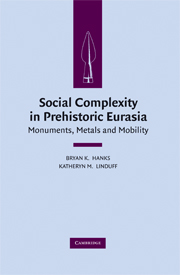Book contents
- Frontmatter
- Contents
- Contributors
- Foreword: From Myth to Method: Advances in the Archaeology of the Eurasian Steppe
- CHAPTER 1 Introduction: Reconsidering Steppe Social Complexity within World Prehistory
- PART ONE FRAMING COMPLEXITY
- PART TWO MINING, METALLURGY, AND TRADE
- CHAPTER 7 Introduction
- CHAPTER 8 Formation of the Eurasian Steppe Belt Cultures: Viewed through the Lens of Archaeometallurgy and Radiocarbon Dating
- CHAPTER 9 Late Prehistoric Mining, Metallurgy, and Social Organization in North Central Eurasia
- CHAPTER 10 The Bronze-Using Cultures in the Northern Frontier of Ancient China and the Metallurgies of Ancient Dian Area in Yunnan Province
- CHAPTER 11 Production and Social Complexity: Bronze Age Metalworking in the Middle Volga
- CHAPTER 12 Early Metallurgy and Socio-Cultural Complexity: Archaeological Discoveries in Northwest China
- PART THREE FRONTIERS AND BORDER DYNAMICS
- PART FOUR SOCIAL POWER, MONUMENTALITY, AND MOBILITY
- Index
CHAPTER 10 - The Bronze-Using Cultures in the Northern Frontier of Ancient China and the Metallurgies of Ancient Dian Area in Yunnan Province
from PART TWO - MINING, METALLURGY, AND TRADE
Published online by Cambridge University Press: 26 January 2010
- Frontmatter
- Contents
- Contributors
- Foreword: From Myth to Method: Advances in the Archaeology of the Eurasian Steppe
- CHAPTER 1 Introduction: Reconsidering Steppe Social Complexity within World Prehistory
- PART ONE FRAMING COMPLEXITY
- PART TWO MINING, METALLURGY, AND TRADE
- CHAPTER 7 Introduction
- CHAPTER 8 Formation of the Eurasian Steppe Belt Cultures: Viewed through the Lens of Archaeometallurgy and Radiocarbon Dating
- CHAPTER 9 Late Prehistoric Mining, Metallurgy, and Social Organization in North Central Eurasia
- CHAPTER 10 The Bronze-Using Cultures in the Northern Frontier of Ancient China and the Metallurgies of Ancient Dian Area in Yunnan Province
- CHAPTER 11 Production and Social Complexity: Bronze Age Metalworking in the Middle Volga
- CHAPTER 12 Early Metallurgy and Socio-Cultural Complexity: Archaeological Discoveries in Northwest China
- PART THREE FRONTIERS AND BORDER DYNAMICS
- PART FOUR SOCIAL POWER, MONUMENTALITY, AND MOBILITY
- Index
Summary
During the period of the Shang through the Han dynasty (c. 1250 bce – 220 ce), mobile pastoralists who lived in the beifang, or the Northern Frontier of ancient dynastic China, contributed to and strongly influenced the emerging Chinese civilization. Their effect was felt not only in the northern territories and Central Plain of China but also in the southwest. The examination of the impact of these mobile peoples on local bronze cultures has ignited the interest and attention of many scholars; however, little attention has been given to their contribution to the distinctive culture, or cultures, of what is now southwestern China.
The ancient text called the Shiji (Records of the Grand Historian) suggested that during the period of the Warring States and the Han Dynasty (fifth century bce–second century ce), there was a state called Dian near Lake Dianchi in present-day Yunnan Province in southwestern China. There have been many different views about the formation and origination of the metal culture of the Dian State. One recent proposal is that the Dian was made up of a mixture of peoples from the Baipu (from the Chu State in south-central China), of Diand Qiang (pastoral peoples from the north), and a local population (Kunming yangfutou 2005). The purpose of this chapter is to investigate metallurgical technologies used in the state of Dian and to explore the implications of that in relation to interaction with peoples from the beifang, or the Northern Frontier.
In the past 50 years, thousands of metal objects were unearthed from dozens of Bronze Age cemeteries excavated in the ancient Dian region (Fig. 10.1).
- Type
- Chapter
- Information
- Social Complexity in Prehistoric EurasiaMonuments, Metals and Mobility, pp. 168 - 186Publisher: Cambridge University PressPrint publication year: 2009
- 1
- Cited by

